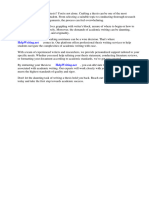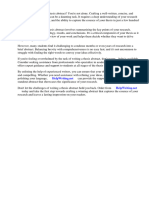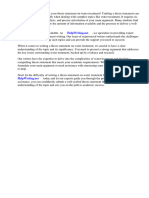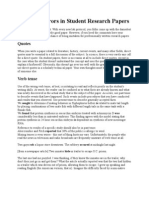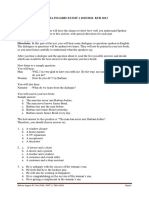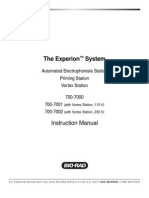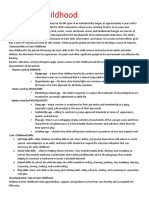0 ratings0% found this document useful (0 votes)
26 viewsProject 1
Project 1
Uploaded by
api-253716121Copyright:
© All Rights Reserved
Available Formats
Download as DOCX, PDF, TXT or read online from Scribd
Project 1
Project 1
Uploaded by
api-2537161210 ratings0% found this document useful (0 votes)
26 views3 pagesOriginal Title
project 1
Copyright
© © All Rights Reserved
Available Formats
DOCX, PDF, TXT or read online from Scribd
Share this document
Did you find this document useful?
Is this content inappropriate?
Copyright:
© All Rights Reserved
Available Formats
Download as DOCX, PDF, TXT or read online from Scribd
Download as docx, pdf, or txt
0 ratings0% found this document useful (0 votes)
26 views3 pagesProject 1
Project 1
Uploaded by
api-253716121Copyright:
© All Rights Reserved
Available Formats
Download as DOCX, PDF, TXT or read online from Scribd
Download as docx, pdf, or txt
You are on page 1of 3
MEMORANDUM
To: Professor Karen Thompson
From: Jessie Balbiani
Date: 2 February 2014
Subject: Project 1 Writing to Achieve a Readable Style
This memo attempts to analyze the prose of two scientific papers previously written during my
environmental science education at the University of Idaho. One paper is an informative essay on
energy resources in Washington State. The other paper is my undergraduate thesis proposal. The
purpose of the analysis was to determine the readability of my style based on four characteristics :
being concise, use of jargon, avoiding long sentences, and being precise. In both papers I have
found examples of good and poor prose style. Below I have organized the examples based on the
four characteristics of good prose and included corrections to improve my previous writing.
Being Concise
The purpose of most scientific writing is to convey information or data effectively and efficiently. In
order to do so, it is important to be concise. Being concise means to eliminate unnecessary words
from your writing with the intent to simplify and clarify your language. This not only helps the
reader maintain interest in your writing but also prevents confusion and misinterpretation. I found
unnecessary wordiness as well as repetitive language in both of my previous writing examples.
Below is an example from the informative paper in which I have highlighted areas that could use
improvement:
By the year 2010, 66.5 percent of energy produced in the state came from
hydroelectric power as a result of multiple dams along the Snake and Columbia
rivers.
The phrase the year in unnecessary since 2010 is obviously a date and not numerical data. Since
Washington was previously identified as the location, writing in the state is implied and therefore
redundant. The phrase as a result can be simplified to from and the use of multiple is
redundant since dams is plural. The concise sentence would read as follows:
By 2010, 66.5 percent of energy produced came from hydroelectric power from
dams along the Snake and Columbia rivers.
The sentence above is much more straightforward and easy to understand. Below is
another example from the thesis proposal:
When excess phosphorus becomes available in aquatic ecosystems, the system becomes
nitrogen limited. As a result a phytoplankton community dominated by cyanobacteria is
favored because cyanobacteria can fix atmospheric N and thus overcome N-limitation
(Redfield, 1958). This ability allows cyanobacteria populations to thrive in N-limited
conditions, resulting in large algae blooms.
In this example, the phrase as a result is unnecessary and can be deleted. The word ability is
considered redundant. The use of this at the beginning of the sentence clearly references the
ability of cyanobacteria to fix nitrogen in the preceding sentence, therefore making it unnecessary
to restate the word ability.
Use of Jargon
Jargon is any word or expression specific to one profession and is not considered part of the
common knowledge base. Avoiding excessive jargon in scientific writing can be difficult. It is always
good to assume the reader does not have the same background knowledge on the subject as you,
the writer. Therefore it is always good to incorporate definitions into your writing following a term
or subject that is likely to be unfamiliar to the reader. Below are some good examples of defining
terms from my previous writing. I have underlines the term that is considered jargon and then
highlighted the sentence that defines that term.
Algae take up these nutrients in quantities outlined by Redfields ratio (Falkowski,
2000), which states that in a balanced system phytoplankton consume one
phosphorus for every seven nitrogen by mass (Wetzel, 2001).
One mitigation strategy available to Washington State is sequestering carbon
dioxide produced from the coal-fired plant. Carbon sequestration is the process of
capturing carbon dioxide emissions from the stacks of electrical plants, condensing
it, and storing it in porous rock below the surface of the earth.
Such blooms can potentially degrade drinking water quality and destroy fisheries if
cyanotoxins, poisons produced by some cyanobacteria, are present.
However, there were many terms in my writing that were not clearly identified and could
confuse a reader unfamiliar with limnology or environmental science. Below is a list of
terms and acronyms from my writing that could use clarification:
Turbidity
Anoxic
Aerobic
Anaerobic
Hypolinmion
Epilimnion
Eutrophication
Stratification
Positive Feedback
Addendum
Subbasin
Fall Turnover
Internal Loading
Oligotrophication
TP
P
N
Ppm
Inundated
[ ] (concentration
Avoid Long Sentences
The term long is definitely relative. Long sentence often are unavoidable or necessary for the
specific paper. Therefore this rule of good prose style is almost a personal preference. However,
writers should be aware of over using long sentences. Multiple long, sequential sentences can
confuse the reader and cause them to lose track of your purpose. Avoiding long sentences is also
another way of being concise (see page 1). Long sentences also tend to include a lot of fluff or
words that arent essential for conveying the desired message or information. Sometimes entire
sentences can be fluff. The example below is from my thesis proposal:
Water is an essential component of all life and as such it is arguably the most
valuable resource on earth. To use the words of Nobel Prize winner and biochemist
Albert Szent-Gyorgyi, water is lifes matter and matrix, mother and medium there
is no life without water. And yet it remains one of the most threatened resources
by human behavior.
While these three sentences were meant to act as an introduction to my thesis proposal with the
intent of hooking the reader, they are unnecessarily long. I could have easily conveyed the same
idea in one sentence rather than three fluffy sentences. See below:
Water is an essential component of all life and yet it remains one of the most threatened
resources by human behavior.
By eliminating the quote from a Nobel Prize winner, some may say that the introduction loses
credibility. However by slimming down the sentences and eliminating the quote, the reader is able
to quickly grasp what the thesis proposal is about in a shorter amount of time. This is essential
when presenting a thesis.
Being Precise
Being precise and being clear often go hand in hand. In scientific writing it is important to phrase
your sentence in such a way as to not create unnecessary confusion. This can also happen when
vague language is used. I noticed throughout my writing that I used complicated sentence structure
that was difficult to follow and vague language.
An easy way to make sure you are being precise when conveying information is to organize the
information in a list. See the example for my informative paper below:
The remaining 33.5 percent is divided up as follows: 8.2 percent coal, 10 percent
natural gas, 8.9 percent nuclear, and 6.4 percent other renewable sources such as
biomass, geothermal, solar thermal, photovoltaic, and wind.
Here I was able to convey a large amount of information in an organized and efficient
manner. The reader is easily able to follow the data and interpret what the numbers
represent.
Conclusion
In conclusion, it seems that my writing includes both good and bad examples of prose style.
At times I was incredibly wordy and included too much fluff, perhaps in pursuit of a
desired page length. I would say being concise is my greatest challenge while avoiding
jargon is my strength.
You might also like
- Download Full The Personality Puzzle 7th Edition David C. Funder PDF All ChaptersDocument60 pagesDownload Full The Personality Puzzle 7th Edition David C. Funder PDF All Chaptersgeztkude83% (6)
- Develop Positive and Respectful Relationships With Children Task 2Document20 pagesDevelop Positive and Respectful Relationships With Children Task 2Matheus Felipe Lessa Oliveira100% (4)
- Introduction To Built Environment - StdntversionDocument14 pagesIntroduction To Built Environment - StdntversionFiq Sapitos100% (1)
- Sainani WritingDocument45 pagesSainani WritingMisis Krung PNo ratings yet
- Essential Natural Hygiene Home Study Course: Lesson ENH01Document46 pagesEssential Natural Hygiene Home Study Course: Lesson ENH01infusion1967100% (3)
- Assignment 1 Readability of Writing StyleDocument3 pagesAssignment 1 Readability of Writing Styleapi-273740475No ratings yet
- Sullivan Project 1Document3 pagesSullivan Project 1iansullivan24No ratings yet
- Woodruff Project 01Document3 pagesWoodruff Project 01api-285837049No ratings yet
- Paraphrasing PDFDocument3 pagesParaphrasing PDFThuy DuongNo ratings yet
- Handout Le с ture 1 Academic Writing: All problems could be divided into classesDocument11 pagesHandout Le с ture 1 Academic Writing: All problems could be divided into classesStefanie MuroyaNo ratings yet
- 10 5923 J Edu 20130302 04Document5 pages10 5923 J Edu 20130302 04Naga LakshmiNo ratings yet
- Example of Thesis Abstract in EnglishDocument4 pagesExample of Thesis Abstract in Englishheatherfreekindependence100% (2)
- Guide On Writing Bio EssaysDocument5 pagesGuide On Writing Bio Essaysacecula9No ratings yet
- Tutorial Letter 201/1/2018: Applied English Language Studies: Further ExplorationsDocument9 pagesTutorial Letter 201/1/2018: Applied English Language Studies: Further Explorationsthemegirl28No ratings yet
- Semi Colon Colon v1 0Document2 pagesSemi Colon Colon v1 0patel agrocenterNo ratings yet
- Research Grade 7 ParaphrasingDocument8 pagesResearch Grade 7 ParaphrasingSophia IsabelleNo ratings yet
- KULIAH WEEK 2Document37 pagesKULIAH WEEK 2fanaeriuNo ratings yet
- Coherence & CohesionDocument11 pagesCoherence & Cohesionasadbekmatyokubov1812No ratings yet
- Cut Lard - Redundant Words & Dead PhrasesDocument4 pagesCut Lard - Redundant Words & Dead Phrasesapi-357159480No ratings yet
- Instructor Feedback For Research Analysis Essay 1Document4 pagesInstructor Feedback For Research Analysis Essay 1api-709491226No ratings yet
- Session 4 - Group 3Document10 pagesSession 4 - Group 3KaislaNo ratings yet
- How To ParaphraseDocument4 pagesHow To ParaphraseSir RilvenNo ratings yet
- Example of Good Thesis AbstractDocument4 pagesExample of Good Thesis AbstractBuyPapersOnlineForCollegeEugene100% (2)
- Guidelines For Writing Science Lab ReportsDocument13 pagesGuidelines For Writing Science Lab ReportsBb099 MNo ratings yet
- Writing An Abstract, Précis, or SummaryDocument19 pagesWriting An Abstract, Précis, or SummaryJosielyne GervacioNo ratings yet
- WritiDocument5 pagesWritiMoniqueGilNo ratings yet
- Fishing Thesis StatementDocument7 pagesFishing Thesis Statementtmexyhikd100% (2)
- Lesson 25 8th TermDocument4 pagesLesson 25 8th TermshaxrizodabarakayevaNo ratings yet
- Module 1: An Approach To Aw Considerations in AW: 1. Description ofDocument10 pagesModule 1: An Approach To Aw Considerations in AW: 1. Description ofAMNo ratings yet
- Cohesion and CoherenceDocument6 pagesCohesion and CoherenceShelvy RojasNo ratings yet
- For Students-Paraphrasing - Summarising and In-Textt Citation - Key To PP 49 and 51 - 52Document7 pagesFor Students-Paraphrasing - Summarising and In-Textt Citation - Key To PP 49 and 51 - 52mrakmasa04No ratings yet
- Paraphrasing: A Paraphrase IsDocument4 pagesParaphrasing: A Paraphrase IsVictor MaldonadoNo ratings yet
- The Writing Center PDFDocument7 pagesThe Writing Center PDFdhanuNo ratings yet
- B GuidelinesDocument13 pagesB GuidelinesNashwa KamalNo ratings yet
- Common MistakesDocument16 pagesCommon Mistakesprinceofwales2007No ratings yet
- Thesis Statement Water TreatmentDocument8 pagesThesis Statement Water Treatmentvictoriaburkeatlanta100% (1)
- Bower - Escritura Académica de PaperDocument3 pagesBower - Escritura Académica de PaperMvNo ratings yet
- Definitions of Cohesion and CoherenceDocument6 pagesDefinitions of Cohesion and CoherenceTori SpiritNo ratings yet
- Introduction To Scientific Writing BasicsDocument12 pagesIntroduction To Scientific Writing BasicszafarNo ratings yet
- Guidelines and Helpful Hints From The Purdue OWL: Writing An Research-Based Argument EssayDocument5 pagesGuidelines and Helpful Hints From The Purdue OWL: Writing An Research-Based Argument EssayStickTobySanchezPanduroNo ratings yet
- What Are The Differences Among Quoting, Paraphrasing, and Summarizing?Document6 pagesWhat Are The Differences Among Quoting, Paraphrasing, and Summarizing?kholaNo ratings yet
- Lertzman 1995 BESADocument7 pagesLertzman 1995 BESAJames HucsonNo ratings yet
- Week 3 - Writing Materials 3 - Sentence and Parapgraph-Level Paraphrasing Pack For StudentsDocument15 pagesWeek 3 - Writing Materials 3 - Sentence and Parapgraph-Level Paraphrasing Pack For Studentsenes.iltasNo ratings yet
- TS Bio Lab Report 3 PDFDocument10 pagesTS Bio Lab Report 3 PDFMainzaNo ratings yet
- ParaphrasingDocument3 pagesParaphrasingAgni Hanandheya Ardhana 22No ratings yet
- Common Errors in Student Research PapersDocument7 pagesCommon Errors in Student Research Papersserbia80100% (2)
- Research Proposal WritingDocument2 pagesResearch Proposal WritingrusruletiNo ratings yet
- T7 Elite Writers GuideDocument7 pagesT7 Elite Writers Guidebravin2wanyonyiNo ratings yet
- HandoutDocument2 pagesHandoutluonghuonggiang.workNo ratings yet
- Literature Review GlossaryDocument5 pagesLiterature Review Glossaryafmzxhvgfvprhm100% (1)
- How To Write A Scientific PaperDocument3 pagesHow To Write A Scientific Paperapi-260736082No ratings yet
- Clauses of Concession in Written Present-Day British EnglishDocument22 pagesClauses of Concession in Written Present-Day British EnglishsalwafailasifaNo ratings yet
- Fempire Evolve Training GuideDocument6 pagesFempire Evolve Training GuideJapheth NgugiNo ratings yet
- Scientific English:: Getting Your Writing RightDocument12 pagesScientific English:: Getting Your Writing RightAndre ChouNo ratings yet
- Paraphrasing PDFDocument3 pagesParaphrasing PDFhasanNo ratings yet
- Scientific Research Proposal TemplateDocument2 pagesScientific Research Proposal TemplateFABIEN KENMOGNENo ratings yet
- Summarizing and ParaphrasingDocument31 pagesSummarizing and ParaphrasingMukkesh NairNo ratings yet
- How To Write - 14Document15 pagesHow To Write - 14NMNo ratings yet
- Avoiding Plagiarism SlidesDocument38 pagesAvoiding Plagiarism SlidesLaila FaeizahNo ratings yet
- Eapp 5 Features of Academic WritingDocument6 pagesEapp 5 Features of Academic WritingKristine Jade PumarinNo ratings yet
- Lecture 4Document4 pagesLecture 4Ника УстиноваNo ratings yet
- The Paramedic MethodDocument5 pagesThe Paramedic MethodNoel MartinNo ratings yet
- wp2 RevisedDocument8 pageswp2 Revisedapi-757972353No ratings yet
- Apha 2012Document1 pageApha 2012ririn677No ratings yet
- An Introduction To The History of Science - Walter Libby, Carnegie (1917)Document325 pagesAn Introduction To The History of Science - Walter Libby, Carnegie (1917)Waterwind100% (1)
- The Beast of Bodmin MoorDocument2 pagesThe Beast of Bodmin MoorAvaan SinhaNo ratings yet
- Week 9-10 Ap2 Wokrsheet Respiratory SystemDocument5 pagesWeek 9-10 Ap2 Wokrsheet Respiratory Systemciixu73No ratings yet
- Paroxysmal DyskinesiasDocument24 pagesParoxysmal DyskinesiasRuben FemmininiNo ratings yet
- Jadwal Dan Silabus P4R Jul 2020Document15 pagesJadwal Dan Silabus P4R Jul 2020YolandaMartaLenaNo ratings yet
- Basic Tools in NutritionDocument3 pagesBasic Tools in NutritionRowena Ayomen-Salibungey100% (2)
- Excel Grade 5 LessPlans Mod 1Document23 pagesExcel Grade 5 LessPlans Mod 1Narine HovhannisyanNo ratings yet
- Ellingson Ryan CV WebDocument6 pagesEllingson Ryan CV Webapi-300956983No ratings yet
- SOAL INGGRIS 1st Semester XI 2015 KUR 2013 B PURDocument11 pagesSOAL INGGRIS 1st Semester XI 2015 KUR 2013 B PURIda Nuryani WijayaNo ratings yet
- Schizophrenia: The Fundamental Questions: Nancy C. AndreasenDocument7 pagesSchizophrenia: The Fundamental Questions: Nancy C. AndreasenJuan InsignaresNo ratings yet
- The Experion System: Instruction ManualDocument40 pagesThe Experion System: Instruction ManualAhmad Adel El TantawyNo ratings yet
- XXXZZZDocument3 pagesXXXZZZSunnyEesuNo ratings yet
- Experiment 5 - General and Specific Tests For CarbohydratesDocument18 pagesExperiment 5 - General and Specific Tests For CarbohydratesArthur Lorenz Paraguison100% (2)
- Muscle AnatomyDocument7 pagesMuscle AnatomyKing4RealNo ratings yet
- Darwin Vs Lamarck Worksheet Answer KeyDocument4 pagesDarwin Vs Lamarck Worksheet Answer KeyFlorence Alexa LopezNo ratings yet
- SBT 703-MicrobiologyDocument132 pagesSBT 703-MicrobiologyThammana NishithareddyNo ratings yet
- Vocabathon Word List For - 2021-22: Spell It Right'Document5 pagesVocabathon Word List For - 2021-22: Spell It Right'Anushka TripathiNo ratings yet
- Anatomy of the Thoracic DiaphragmDocument31 pagesAnatomy of the Thoracic Diaphragmakpakwuisaac3No ratings yet
- Living A Miraculous LifeDocument31 pagesLiving A Miraculous Lifemonicasumoy100% (1)
- TRN1580530 7698837 Clinical Report 1666029364641932Document6 pagesTRN1580530 7698837 Clinical Report 1666029364641932pratimadeshlahreNo ratings yet
- Characteristics of Late ChildhoodDocument73 pagesCharacteristics of Late ChildhoodReycel De Vera ToleteNo ratings yet
- New Species of "Tiger-Milk" Mushroom in Malaysia, Named As Lignosus TigerusDocument7 pagesNew Species of "Tiger-Milk" Mushroom in Malaysia, Named As Lignosus TigerusLignosus RhinocerusNo ratings yet
- A Memorable Event in My LifeDocument7 pagesA Memorable Event in My LifeRulz ZamanNo ratings yet
- PDF 21Document79 pagesPDF 21scorpion2001glaNo ratings yet
- Lecture 2Document45 pagesLecture 2Ashley NguyenNo ratings yet












